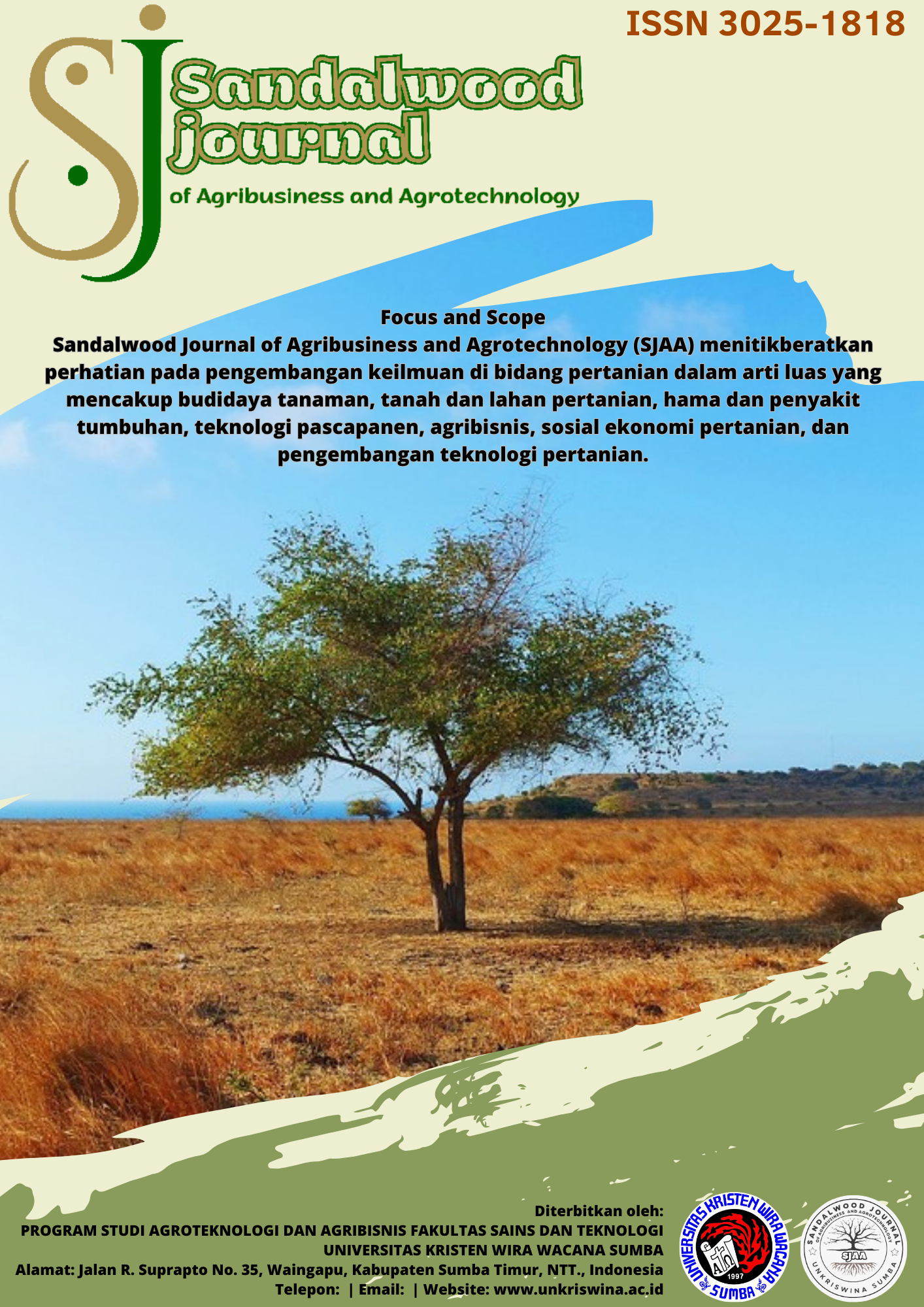Growth and Yield Response of Groundnut (Arachis hypogaea L.) through Application of Goat Feces Bokashi Fertilizer and Kirinyu with Dose Variations
DOI:
https://doi.org/10.58300/sjaa.v3i1.1179Keywords:
Bokashi, Kotoran Kambing, Kimia Tanah, Tanah MerahAbstract
This study aims to evaluate the growth response and yield of peanut plants (Arachis hypogaea) to the application of bokashi kachung fertilizer at varying doses. The study used a completely randomized design (CRD) consisting of five dose treatments, each repeated four times, resulting in 20 experimental units. The treatments included the application of bokashi fertilizer at doses of 10, 15, 20, and 25 tons/ha. The results showed that bokashi application at 14, 28, and 42 days after planting (DAP) tended to increase plant height and leaf number, although there were no statistically significant differences between doses. However, there was a tendency that higher bokashi fertilizer doses resulted in better plant growth responses. In terms of yield, treatment P4 (25 tons/ha) yielded the highest values for all production parameters, including the number of pods per plant, fresh and dry weight of pods per plant, and weight of 100 seeds. These findings confirm that bokashi fertilizer has potential as an effective organic fertilizer alternative to support peanut growth and production. Therefore, the use of bokashi fertilizer can be a sustainable strategy to enhance agricultural productivity
Downloads
References
Hapsari, A. Y. 2013. Kualitas Dan Kuantitas Kandungan Ppupuk Organik Limbah Serasah Dengan Inokulum Kotora Sapi Secara Semianaerob. Universitas Muhammadiyah Surakarta
Kory, W. G. & U. P. Jawang. 2024. Respon Pertumbuhan dan Hasil Terung Ungu (Solanum melongena L) Terhadap Perlakuan Bokashi Kotoran Kuda dan Sekam Padi. Sandalwood Journal Vol. 02 No.02 : 10-15.
Koten, B. B., Wea R., Tiry R. K., Otto S., Belandina S., A. W., Yikwa W., & Titong, A. P. (2020). The Effect of Adding Various Levels of Bokashi from Gliricidia Leaves and Goat Faeces on the Growth, Production and Chemical Composition of Arbila’s (Phaseolus lunatus L.) Forage. Buletin Peternakan. 46(2).
Maula, Indi Millatul. 2023. Pengelolaan Limbah Pertanian: Pemanfaatan Kotoran Kambing Sebagai Pupuk Organik. Action Research Literate, Vol. 1, No. 1, Januari 2023.
Meidina, E. & Suwardi, S. 2024. Pengaruh Dosis Pupuk Organik Kotoran Kambing Terhadap Pertumbuhan dan Produksi Beberapa Varietas Kedelai (Glycine max L). Produksi Tanaman, 012(03), 160-167.
Murdaningsih & Yosefa Sapo Mbu’u. 2014. Pemanfaatan Kirinyu (Chromolaena odorata) Sebagai Sumber Bahan Organik Terhadap Pertumbuhandan Hasil Tanaman Wortel (Daucus carota). Buana Sains Vol.14 No 2: 141-147, 2014
Nasrullah, Ibrahim, B., & Robbo, A. 2023. Pengaruh Pemberian Berbagai Macam Pupuk Organik Padat Terhadap Kemampuan Tanah Menyimpan Air. Jurnal AGrotekMAS Vol. 4 No. 2 Agustus 2023 ISSN : 2723-620X
Pranata, A. S. 2010. Meningkatkan hasil panen dengan pupuk organik. AgroMedia.
Oktavia, L. (2018). Pupuk Organik Cair Campuran daun Kirinyu (Chromolaena odorata) dan Kotoran Kambing untuk Pertumbuhan Sawi Caisim (Brassica juncea L) secara hidroponik NFT. Tesis. UAJY.
Hartatik, Wiwik, Husnain, & Ladiyani R. Widowati. 2015. Peranan Pupuk Organik dalam Peningkatan Produktivitas Tanah dan Tanaman. Jurnal Sumberdaya Lahan Vol. 9 No. 2, Desember 2015; 107-120
Sembiring, M., R. Sipayung, & F. E. Sitepu. 2014. Pertumbuhan dan Produksi Kacang Tanah dengan PemberianKompos Tandan Kosong Kelapa Sawit Pada Frekuensi Pembumbunan yang Berbeda. J. Online Agroekoteknologi 2(2): 598- 607.
Sulistiyono, N. B. E. & Nurdiansyah, W. 2024. Pengaruh Jenis Mulsa dan Pupuk Kandang Kambing Terhadap Produksi Benih Kacang Hijau (Vigna radiate L). In Agropross : National Conference Proceedings of Agriculture (pp.326-334).


